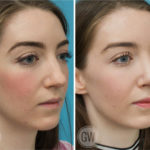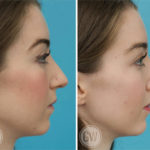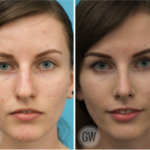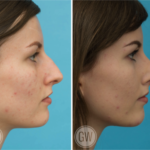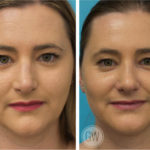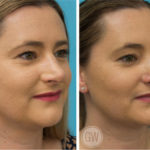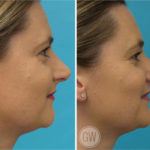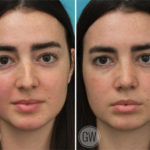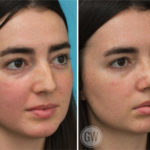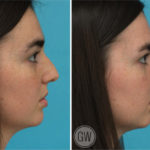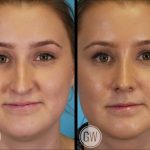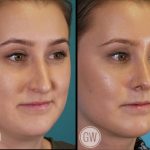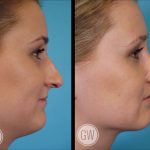This website contains imagery which is only suitable for audiences 18+.

Rhinoplasty
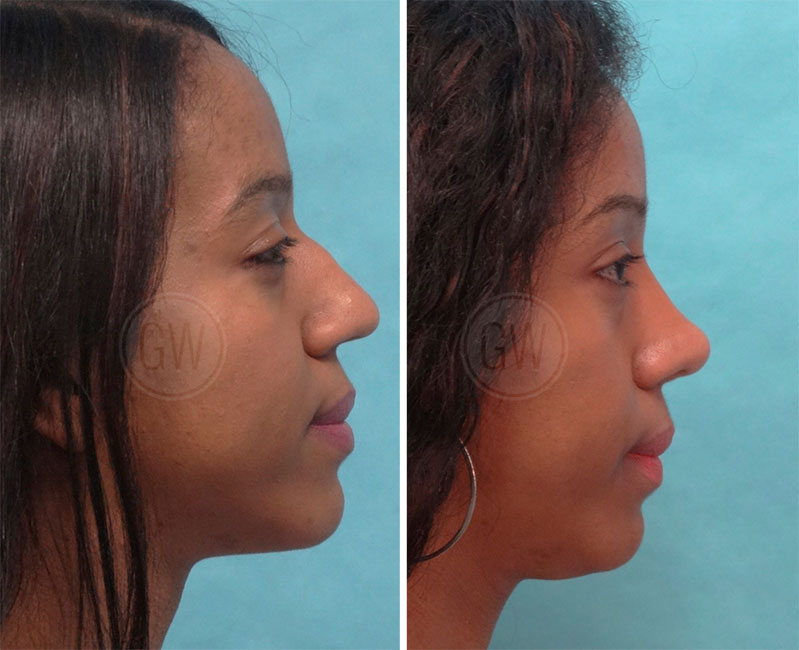
What is Rhinoplasty?
Rhinoplasty is a surgical procedure aimed at reshaping or resizing the nose to alter facial harmony and balance. This intricate procedure can address a variety of concerns, including the overall size of the nose in relation to facial balance, the width of the nose at the bridge, the appearance of bumps or depressions on the bridge, the nasal tip that may be enlarged or significantly pointed downward, excessively flared nostrils and asymmetry of the nose.
Beyond cosmetic alterations, Rhinoplasty can also alleviate functional issues. This includes rectifying structural abnormalities that cause chronic congestion and breathing problems.
DOWNLOAD DR WATTS’ ULTIMATE GUIDE TO RHINOPLASTY
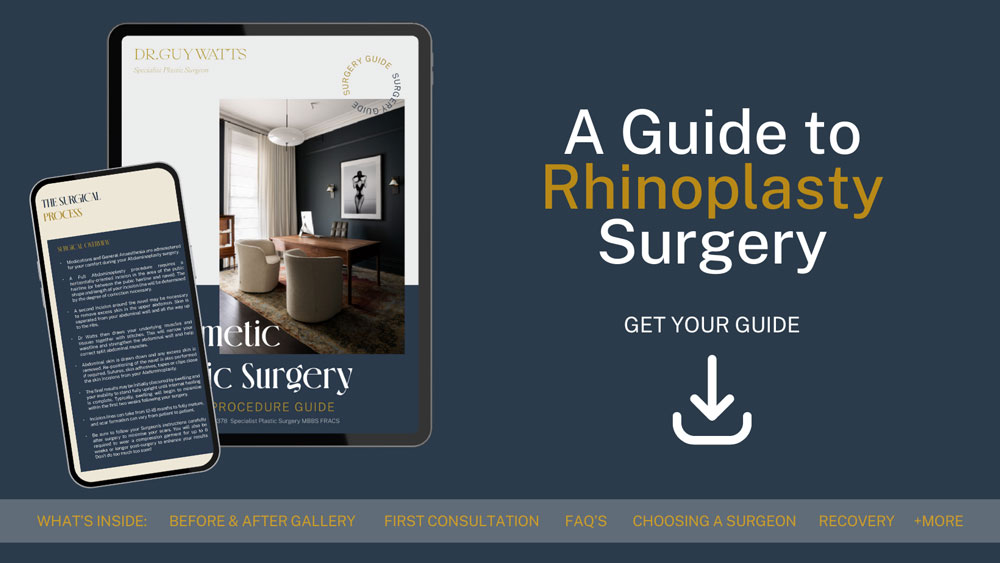
TYPES OF RHINOPLASTY
Rhinoplasty procedures can be categorised into several types, each designed to address specific concerns and goals:
- Cosmetic Rhinoplasty: This form of Rhinoplasty is performed to change the nose’s shape and appearance for aesthetic reasons. It can involve resizing, reshaping, straightening, or refining specific areas of the nose
- Functional Rhinoplasty: This type focuses on increasing the function of the nose, often related to breathing difficulties. It may involve surgery for a deviated septum or other structural issues within the nasal passages
- Revision Rhinoplasty: Also known as secondary Rhinoplasty, this procedure is performed to alter the results of a previous nose surgery. Revision Rhinoplasty is often more complex than primary Rhinoplasty due to the changes already made to the nasal structures. Please note that Revision Rhinoplasty is only available to patients under Dr Guy Watts’s care for Rhinoplasty. Dr Watts does not take on any patients who have had any previous surgery on their nose.
- Ethnic Rhinoplasty: Tailored to respect and preserve the ethnic characteristics of the patient’s nose, this approach requires a deep understanding of the distinct facial features and aesthetic preferences associated with different ethnic backgrounds
- Adolescent Rhinoplasty: Performed on teenagers, this type of Rhinoplasty requires careful consideration due to the ongoing facial growth and development in this age group. Emotional maturity and realistic expectations are also crucial factors to consider. Please note Dr Watts will only consult with patients over 18 years of age in his private rooms.
DIFFERENT APPROACHES TO RHINOPLASTY: OPEN VS CLOSED
Rhinoplasty can be performed using two main surgical approaches: open and closed. Each technique has its own advantages and is chosen based on the specific needs and goals of the patient, as well as the complexity of the procedure required.
Open Rhinoplasty
In an Open Rhinoplasty, a incision is made across the columella, the strip of tissue that separates the nostrils. This approach allows Dr. Watts to lift the skin off the tip of the nose and shape the cartilage precisely. It may be particularly beneficial for more complex procedures or when a more comprehensive reshaping is required.
Advantages of Open Rhinoplasty:
- Increased Visibility: Provides a direct view of the nasal structures, allowing for more precise modifications
- Greater Access: Facilitates complex changes, such as extensive reshaping or reconstruction
- Increased Accuracy: Ideal for intricate work like tip refinement or asymmetry correction
Considerations:
- Scarring: Leaves a small scar on the columella, which typically fades over time
- Recovery: May involve slightly more swelling and a longer healing period compared to Closed Rhinoplasty
Closed Rhinoplasty
In Closed Rhinoplasty, all incisions are made within the nostrils, leaving no visible external scars. This approach is typically more suitable for less extensive reshaping and is preferred by patients looking for a less extensive alteration and no external scarring.
Advantages of Closed Rhinoplasty:
- No Visible External Scarring: Since incisions are inside the nostrils, there are no external scars
- Recovery Time: Typically involves less swelling and a shorter healing period compared to Open Rhinoplasty
- Procedure Time: Often takes less time to perform than Open Rhinoplasty
Considerations:
- Limited Access: Offers less exposure to nasal structures, which might not be suitable for more complex cases
- Reduced Visibility: The surgeon has a more limited view, which may affect the ability to make extensive changes
Choosing the Right Approach
The choice between Open and Closed Rhinoplasty depends on several factors, including the patient’s nasal anatomy, the changes desired, and the complexity of the surgery. Dr. Watts evaluates each patient’s unique situation and discusses the most appropriate approach for their specific needs and goals. His experience in both techniques makes sure that patients receive an optimal outcome, tailored to their individual requirements.
In both Open and Closed Rhinoplasty, Dr. Watts’s priority is to achieve a aesthetically pleasing result that meets the patients desires and facial features while addressing any functional issues.
WHO IS A GOOD CANDIDATE FOR RHINOPLASTY?
Good candidates for Rhinoplasty are typically individuals seeking alteration in the appearance or function of their nose. Key criteria includes:
- Physical Maturity: Candidates should have a fully developed nose, typically by their mid-teens
- Good Overall Health: Candidates should be in good general health, without any medical conditions that impair healing
- Non-smokers or Willing to Quit: Smoking can significantly impair healing and increase the risk of complications. Candidates who smoke will be advised to quit both prior to surgery and during recovery
- Realistic Expectations: It is crucial for patients to have a realistic understanding of what Rhinoplasty can achieve. While the procedure can bring significant changes, it is important to have a clear and realistic expectation of the outcome
- Psychological Readiness: Emotional stability and a clear understanding of the motivations and potential impact of the surgery are important for a satisfactory outcome
Dr. Guy Watts provides comprehensive consultations to discuss individual goals, expectations, and any concerns to determine the suitability for Rhinoplasty.
WHAT CAN A RHINOPLASTY DO FOR ME?
- Reshapes the nose
- Straighten a crooked nose, increasing symmetry and aligning it with your facial structure
- Alters the size of the nose
- Can reshape a bulbous, upturned, or nasal tip that tips downward, altering the overall appearance of the nose
- Alters nostril size and shape
- Alleviates breathing issues
HOW IS THE SURGERY PERFORMED?
Rhinoplasty is performed under general anaesthesia. The procedure can vary depending on the individual’s needs and the desired outcome, but it generally includes the following steps:
- Incision: Depending on the technique used – Open or Closed Rhinoplasty – incisions are made either inside the nostrils or across the columella (the small strip of tissue between the nostrils)
- Reshaping the Nose Structure: The bone and cartilage are reshaped to achieve the desired contour. This may involve removing bone or cartilage, or in some cases, adding tissue
- Alleviating a Deviated Septum: If the septum is deviated, it is straightened, and any projections inside the nose are reduced to increase air flow
- Closing the Incision: Once the reshaping is complete, the skin and tissue are redraped over the new structure of the nose, and the incisions are closed
- Recovery: Initial healing usually involves swelling and some bruising around the eyes, which subsides over time
RECOVERY AFTER RHINOPLASTY
Recovery from Rhinoplasty involves:
- Rest and Elevation: Keeping the head elevated and avoiding strenuous activities is crucial in the first few days
- Managing Discomfort: Pain and discomfort can typically be managed with prescribed medications
- Follow-Up Appointments: These are necessary to remove any nasal packing or splints and to monitor the healing process
- Long-Term Care: Protecting the nose from injury and avoiding strenuous activities for a few weeks is recommended
- Patience with Final Results: Swelling may take up to a year to fully subside, and the final shape of the nose to be apparent
FAQS ABOUT RHINOPLASTY
How long does it take to recover from rhinoplasty?
Full recovery from Rhinoplasty can take up to a year, with most of the noticeable swelling subsiding within a few weeks to months. Initially, patients may experience bruising and swelling, particularly around the eyes and nose, which will dissipate within the first two weeks. It’s important to avoid strenuous activities and follow post-operative care instructions closely, including sleeping with the head elevated and avoiding blowing the nose.
Will the results look natural?
Dr Watts aims to achieve a balance between the nose and the rest of the facial features. During the consultation process, he will discuss your aesthetic goals and use his experience to suggest modifications that will compliment your features.
Can rhinoplasty help with breathing problems?
Yes, Rhinoplasty can alleviate breathing difficulties that are caused by structural issues within the nose that are causing obstructions. Functional Rhinoplasty often involves alleviating a deviated septum or reducing turbinates to increase airflow through the nasal passages.
During the consultation, Dr. Watts will assess your nasal structure and discuss any breathing issues you may have. If functional alterations are needed, he will incorporate these into the surgical plan.
Is there an age limit for rhinoplasty?
While there is no single “ideal” age for Rhinoplasty, it’s generally recommended that patients wait until their nose has finished growing. This is typically around 16-17 years for girls and 17-18 years for boys. For older patients, considerations such as skin elasticity and overall health are important. Dr. Watts evaluates each patient’s physical and emotional maturity, making sure they are ready for the surgery and its implications. Please note Dr Watts will only consult with patients over 18 years of age in his private rooms.
What should I consider when choosing a surgeon for my rhinoplasty?
When choosing a surgeon for Rhinoplasty, consider their qualifications, experience, and qualifications in nasal surgery. Look for a board-certified plastic surgeon with a strong track record in Rhinoplasty. Reviewing before-and-after photos of previous patients can give you an idea of the surgeon’s aesthetic style. It’s also important to have a good rapport with your surgeon and feel comfortable with their approach to your care. During your consultation with Dr. Watts, he will provide detailed information about his experience and approach to Rhinoplasty, so you feel fully informed about your decision.
What are the risks of rhinoplasty?
Rhinoplasty risks include:
- Anaesthesia risks
- Infection
- Bleeding
- Nasal septal perforation
- Unsatisfactory aesthetic result
- Difficulty breathing
- Need for revision surgery
Dr. Watts ensures that all patients are fully informed of these risks and provides detailed instructions to minimise them.
Medical References
- Rhinoplasty – Mayo Clinic
- Rhinoplasty Surgery, Recovery, Before & After – Cleveland Clinic
- Rhinoplasty – American Society of Plastic Surgeons
Next Steps on Your Plastic Surgery Journey
PLEASE TAKE INTO CONSIDERATION
Any surgical or invasive procedure carries risks. Before proceeding, you should seek a second opinion from an appropriately qualified health practitioner.
About Dr. Guy Watts – MED0001539378
FRACS (Plas) – Specialist Plastic Surgeon In Perth WA
Dr. Guy Watts is a Specialist Plastic Surgeon (AHPRA MED0001539378) with an extensive career that spans across renowned plastic surgery clinics worldwide. His experience has been honed through invaluable experiences at esteemed establishments such as the New York Eye and Ear Infirmary and the renowned Pitanguy Clinic in Brazil.
Having collaborated with the foremost cosmetic plastic surgeons on a global scale, Dr. Watts has chosen to return to Perth after a 17-year journey of intensive training and invaluable professional experience to bring the latest practices and technology in cosmetic plastic surgery to his patients.
Dr. Watts is a Fellow of the Royal Australasian College of Surgeons (FRACS) and a Member of the Australian Society of Plastic Surgeons (ASPS), Australasian Society of Aesthetic Plastic Surgeons (ASAPS) and the International Society of Aesthetic Plastic Surgeons (ISAPS).
Read about the potential Risks and Complications of Surgery
Read the Patient Information and Resources
About CLINISPA
Clinispa is Dr Watts’ bespoke medical clinic performing Cosmetic Aesthetic treatments. At Clinispa, we offer advanced clinical treatments in a luxurious and calming environment, tailored to support your skin’s health and appearance.
Clinispa aesthetic services are performed by Dr Guy Watts’ nursing professionals, who have a passion for and solid understanding of facial aesthetics.
All Clinispa clients are considered individually, with a personalised treatment plan consisting of advanced scientific approaches to cosmetic aesthetics. We incorporate innovative technologies in conjunction with superiorly formulated skin care.
For more information about the full range of Clinispa Aesthetic of Cosmetic Treatments visit the Clinispa website






